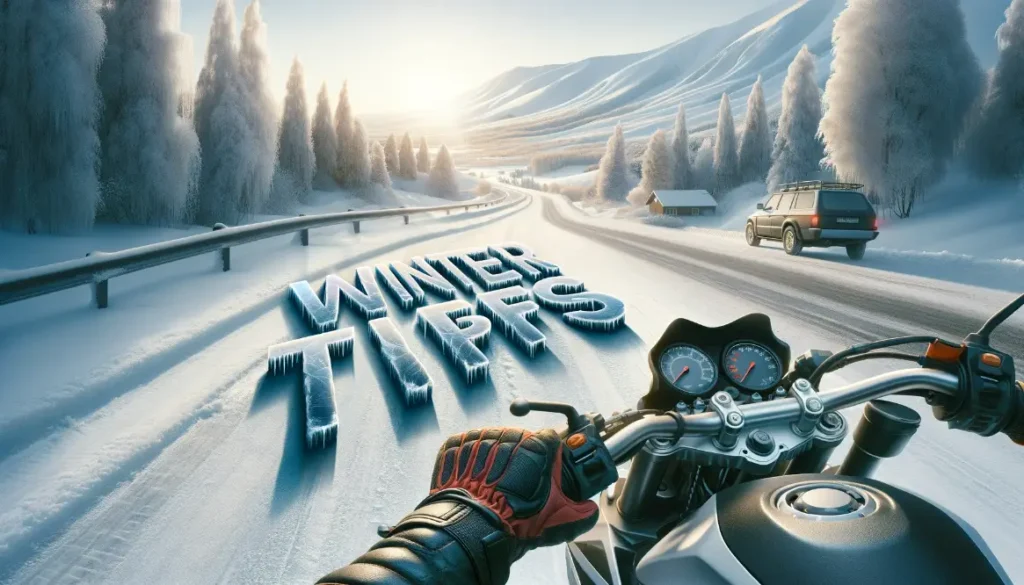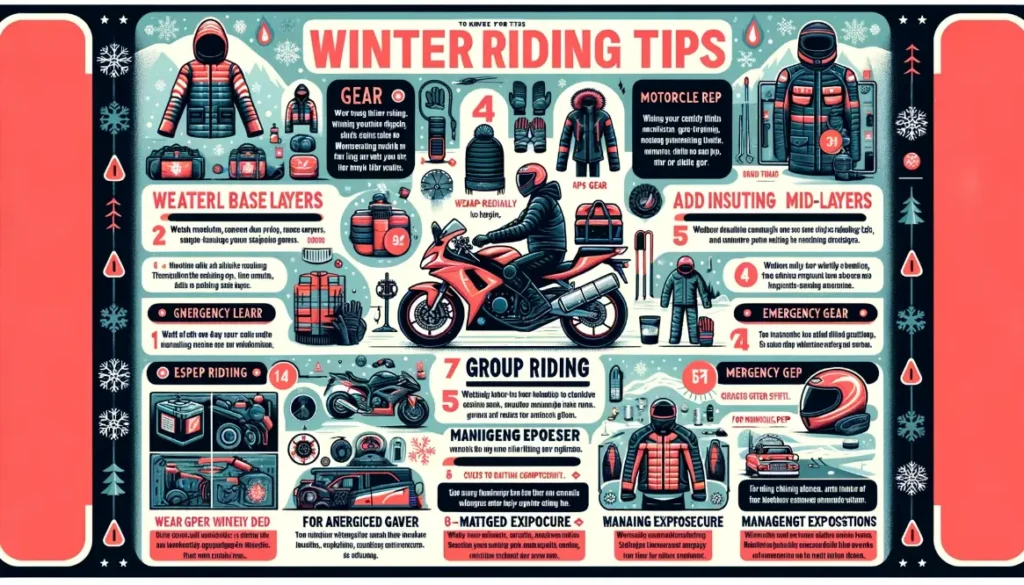
Motorcycle lovers don’t have to park their bikes when the temperatures start dropping and snow starts falling. As long as you wear the right winter motorcycle gear, equip your bike properly, and adjust your riding style for slippery roads, winter can still offer plenty of exciting days in the saddle. Check out these 18 pro tips for riding safely and comfortably all winter long.
Gear Up to Handle the Cold Temperatures
Riding in frigid winter conditions requires wearing specialized layers and equipment to prevent wind chill, retain body heat, and keep extremities warm and dry. Investing in proper cold weather motorcycle gear makes winter commutes much more pleasurable.
Wear Thermal Base Layers Next to Your Skin
Synthetic or merino wool long underwear pulls moisture away from your skin while providing an extra layer of insulation against the cold. Choose a close-fitting thermal top and bottom set made of wicking performance fabrics.
Add Insulating Mid Layers for Warmth
The mid layer trap heat close to your body. Opt for a long-sleeve technical shirt made of wool or fleece and insulated riding pants. Garments with zippered vents allow you to regulate body temperature.
Block Wind and Water with a Sturdy Outer Shell
A windproof and waterproof jacket and overpants form the outermost layer, preventing cold air and snow or rain from reaching the insulating layers underneath. Look for breathable membranes like Gore-Tex combined with sealed seams.
Best winter riding tips
| Category | Tips |
|---|---|
| Gear | – Wear thermal base layers – Add insulating mid layers – Wear waterproof outer shell – Use insulated, waterproof winter boots – Wear heated gloves – Use balaclavas, neck warmers, helmet liners |
| Motorcycle Prep | – Wash regularly to remove salt/grime – Seal exposed metal components – Keep battery charged – Install knobby winter tires – Check antifreeze strength – Adjust suspension settings |
| Riding Technique | – Scan farther ahead – Allow extra stopping distance – Take turns slowly and cautiously – Use both brakes gently – Maintain lower speeds in corners – Stay calm during skids – Align bars in direction of travel – Watch for ice under snow – Watch for slick spots under overpasses & trees |
| Group Riding | – Increase space between riders – Widen staggered formation |
| Emergency Gear | – Carry shovel, sand/salt – Pack chemical warmers – Maintain emergency communications |
| Managing Exposure | – Recognize early signs of hypothermia/frostbite – Seek warm, dry shelter if symptoms appear – Call for medical help if severe |
| Other Tips | – Stay properly hydrated – Take frequent warming breaks – Prepare bike for storage – Inspect and service bike before next season |
Guard Your Paws Against the Elements
Your feet are especially prone to feeling icy when riding in winter conditions. Waterproof winter motorcycle boots with insulation and grippy soles will become your new best friends.
Slip On Cozy Insulated Boots
Look for boots rated for cold and wet weather with features like faux fur lining and 200g insulation. They should be snug-fitting while allowing wiggle room for your toes.
Add Heated Insoles for Toasty Tootsies
Electric insoles powered by compact rechargeable batteries will keep your feet nice and toasty within your winter boots. Heated insoles help combat one of the highest sources of rider discomfort.
Waterproof Your Footwear
A waterproof membrane combined with a gaiter-style cuff prevents snowmelt and other wetness from seeping into your boots and chilling your feet. Seek winter boots made of full-grain leather or vulcanized rubber.
Protect Your Paws with Winter Riding Gloves
Along with your feet, your hands bear the brunt of winter’s bite. Armoring them against the cold allows you to operate the controls safely and pain-free.
Defend Your Digits with Heated Gloves
Electrically-heated gloves let you flip the switch on bone-numbing fingers. They typically heat across the back of the hands and fingers via battery power. Heated winter riding gloves help retain sensitivity in your fingertips.
Shield Hands with Waterproof Winter Gloves
Look for gloves insulated with PrimaLoft or Thinsulate and coated with a waterproof yet breathable membrane. Quality winter riding gloves enable moisture to escape while keeping wind and water outside.
Guard Your Noggin from the Cold
A significant percentage of body heat escapes through your head. Defending it against chilliness goes a long way in preserving comfort while riding in freezing temps.
Wrap a Warming Balaclava Around Your Head
A balaclava protects your head, neck, and face from frigid airflow. Made of breathable fabrics like fleece, it slips under your helmet while allowing goggles or a face shield to fit over it. An opening permits exposure as needed.
Shield Your Neck with a Snug-Fitting Warmer
Neoprene neck warmers help block icy wind from hitting the sensitive neck area between your jacket collar and helmet. Look for ones with adjustable drawstrings that comfortably constrict the neck tube opening.
Insulate Your Helmet with Removable Liners
While your helmet itself should remain well-vented, optional insulation kits and helmet liners transform its interior comfort level for winter riding. Fleece, shearling wool, and other insulating helmet liners provide vital warmth without compromising safety.
Prep Your Bike for Frigid Riding Conditions
Routine motorcycle maintenance and some additional winterizing preparation helps ensure your two-wheeled steed remains happy and hassle-free riding through ice and snow.
Wash Road Salt and Grime Off Regularly
Road treatments like salt and magnesium chloride help melt ice but also promote corrosion as they get kicked up on your bike. Hose grime off your motorcycle after every few winter rides to mitigate damage.
Seal Any Exposed Metal with Protectants
Spray paint, rubberized undercoating, corrosion inhibitors, or vinyl protectants shield vulnerable metal components like your kickstand, foot pegs, exhaust, and chain from the ravages of winter. Reapply frequently.
Keep Your Battery Fully Charged
Cold saps battery voltage, making winter one of the most likely times for battery failure. Use a trickle charger anytime parking your bike. Check electrolyte levels and keep connections clean and covered.
Get Your Bike Dialed for Icy Conditions

While regular tires work fine on cool, dry pavement, special winter motorcycle tires provide essential extra grip and control when roads get slippery and snow-covered.
Install Aggressive Winter Tires with Deep Treads
Knobby tires with wide spaced treads excel at penetrating snow and channeling away slush, water, and other winter slop flung off the front tire. Popular winter tire models include the Dunlop Roadsmart III and Michelin Anakee Wild.
Confirm Antifreeze Strength for Sub-Zero Temps
Check that your bike has a 50/50 mix of antifreeze and distilled water, allowing operation down to 34°F below zero. Antifreeze prevents cylinder, head, and hose freezing while lubricating water pump seals.
Adjust Suspension Settings for Icy Conditions
Dialing in firmer compression and rebound damping settings account for reduced traction by slowing weight transfers. Slowing front end dive and rear end squat makes handling more predictable on slippery roads.
Employ Safe Winter Riding Techniques
While rider skill always trumps outright power, a smooth, strategic approach helps motorcycle and motorcyclist safely navigate snowy or icy conditions.
Scan Farther Ahead for Hazards
Keep your eyes up and focused farther down the road, allowing more time to plan for and respond to traction variances like ice patches, potholes, road debris, and sand piles. Give other vehicles extra room too.
Build in Extra Distance for Stopping
Braking effectiveness gets severely compromised on slick surfaces. Allow several times your normal following distance and begin decelerating earlier. Gradual squeezes of both brake levers rein in speed without locking either wheel.
Take Turns Slowly and Cautiously
Practice feathering the clutch and applying measured throttle through corners. Keep corner lean angles low by hanging off less. Standing up slightly shifts weight to larger-treaded rear tire for enhanced cornering traction.
Adjust Your Braking Finesse for Icy Patches
Braking overly hard or abruptly on slippery surfaces inevitably leads to locked wheels and crashes. Develop nuanced winter braking skills for keeping rubber firmly planted on tarmac.
Grip Both Brakes for Balanced Deceleration
Ideally apply both front and rear binders in an evenly-modulated fashion rather than rely solely on your front brake. Light, 50/50 braking squeezes help retain steering control if the front locks momentarily.
Start Slowing Down Earlier than Normal
Give yourself twice the normal braking distance or more. Gentle early braking prevents the need for hard late grabs that get dicey on ice or packed snow ruts. Rolling off the throttle also lets engine compression help slow you.
Lean and Tip In Cautiously on Icy Corners
While straightaways hold minimal surprises in winter, slippery decreased-radius turns present substantial challenges requiring an almost exaggerated smoothness and precision.
Maintain Lower Speeds Prior to Corner Entry
Resist the temptation to power through turns per usual. Set yourself up for success by bleeding off velocity well before turn-in points and avoiding abrupt throttle adjustments mid-corner.
Minimize Bike Lean Angles on Icy Surfaces
Avoid aggressive cornering lean angles that might upset available traction. Lightly drag your knee as a touch-point rather than driving hard into berm. Utilize core body strength to authority over icy corners.
Skillfully Manage Winter Slides and Skids
Even the best-prepared, most safety-conscious winter rider encounters an occasional front wheel or rear wheel slide. Reacting correctly greatly improves stability.
Stay Calm and Don’t Overreact
Fighting against a skid or allowing it to unnerve you often makes it worse. Avoid chopping the throttle or slamming on brakes during a slide. Just breathe and stay relaxed.
Look Where You Want to Go
Focus your vision on your intended path of travel beyond the skid rather than staring at the snowbank you’re sliding toward. Your bike tends to follow your vision since eyes lead the mind and body.
Regain Traction Following Rear Wheel Spins
Applying throttle and countersteering out of a back wheel skid prevents a possible high side crash. This maneuver also builds confidence for handing slick surfaces.
Align Your Handlebars with Direction of Travel
As soon as possible in the skid, get your front wheel pointed down the actual path you want to ride on. Avoid staring at or steering toward hazards like guardrails or parked cars during the slide.
Roll On the Throttle Smoothly Once Aligned
Cracking open the throttle once your front tire points the right direction transfers weight rearward, pushing the rear tire down to allow regaining grip. Avoid whacking open the throttles since that could wheelie or high-side you.
Exercise Caution Riding Over Snowy Roads
While a couple inches of fresh power makes for scenic winter riding, deep snow hides road hazards and invites low sides and high sides. Adjust entry speed and line choice accordingly.
Watch for Ice Lurking Underneath
Snowpack builds up quickest on top of already-frozen roads. Make sure to scan for shaded areas and ice-prone locations like bridge decks even when covered by snow. Play it safe when in doubt.
Avoid Wrestling with Super Deep Snow
Letting off the gas and allowing momentum to carry you minimizes fighting deep snow ruts. Accelerating or turning sharply risks digging the tires in too deeply and going down. Scan ahead and pick the best lines.
Watch for Slick Spots Under Overpasses & Trees
Bridges and heavily shaded stretches often remain icy long after surrounding areas thaw and dry in late winter. Identifying high-risk zones well in advance bolsters hazard avoidance.
Keep Alert for Isolated Ice Patches
Spring’s warming sunlight gets blocked beneath overpasses, dense trees, and north-facing slopes, preventing ice from fully melting. Make a mental note of these frequent problem areas near your winter riding routes.
Modulate Speed When Approaching Icy Microclimates
Rather than charging into sun-deprived sections where black ice lingers, bleed off speed beforehand. Seriously consider walking your bike across persistent trouble spots to avoid an ugly low side.
Ride in Alert Formation with Friends
The camaraderie of group rides still thrives amid the off-season chill. But allow extra buffer room between riders given available traction fluctuations on cold roads.
Leave Added Gap between Bikes
Double up the spacing between you and bike ahead to allow reacting to handling bobbles or sudden braking. Group riders should resist tailgating like they might during balmier temps.
Fan Out the Staggered Formation
Widen distances between lead, middle, and trailing riders during winter group rides. Communicate protruding road hazards like potholes or icy patches so each rider takes appropriate action.
Be Ready with Key Emergency Supplies
Carrying certain provisions specific to winter riding prepares you to handle common minor mishaps without becoming stranded or too chilled while waiting for assistance.
Pack a Small Shovel and Sand/Salt Mix
A folding shovel and baggie of sand, gravel, or road salt fits easily under a seat or in saddlebags, providing traction if you get stuck off-road or drop your bike crossing ice.
Keep Chemical Warmers Handy
Portable heat packs that warm up when exposed oxygen provide almost instant hand, toe, and body warmth during unplanned stops. Toss a few sets in a zip-top bag that lives year-round in your riding jacket.
Maintain Emergency Communications
A fully-charged phone stowed in an inner, insulated pocket provides access to call for help if injured or broken down. Waterproof handlebar bags keep electronics functioning.
Spot Early Signs of Winter Exposure Issues
Recognizing emerging cold-induced medical issues like hypothermia and frostbite means quickly initiating treatment before they become dire or life threatening riding situations.
Know What Causes Loss of Body Heat
Common causes of hypothermia include wet clothing, frigid temperatures, high winds, improper layering, poor circulation, alcohol consumption, fatigue, and inadequate nutrition. Monitor yourself and fellow riders.
Identify Early Onset of Hypothermia
Catching hypothermia early on increases positive outcomes significantly. Early clues encompass shivering, confusion, slurred speech, frequent stumbling, and complaining about the cold despite adequate gear.
Don’t Dismiss Frostnip and Frostbite
Extremities with less circulation like fingers, ears, and toes get hit first by frostbite. Red skin that whitens or turns waxy yellow hints frostbite is damaging underlying tissue. Act promptly to avoid permanent damage.
Take Action against Mild Exposure Issues
Before cold stress advances too far, retreating to shelter and gently reheating effected body parts often reverses ill effects. But more severe cases require emergency medical intervention.
Seek Warm, Dry Shelter Promptly
Move the victim out of the wind, wetness, and cold into a heated building or vehicle. Remove any damp garments and replace with dry insulation layers to let body rewarm gradually.
Apply Direct Hand Warmers to Frostbitten Areas
After thawing frostbitten areas with body heat, apply chemical warmer packs directly to hands, ears, cheeks, or toes. But avoid rubbing the skin which can further damaged tissues. Seek medical care.
Summon Help for Advanced Hypothermia
Once their body temperature drops dangerously low, severely hypothermic motorcycle riders lose the ability to rewarm themselves without professional medical assistance.
Monitor for Slurred Speech and Mental Confusion
If a hypothermic rider seems unaware of their surroundings or unable to speak clearly, immediately call emergency services. Hypothermia impairs reasoning, so the victim may resist help.
Watch Closely If Shivering Stops
One of the most critical warning signs happens when shivering ceases despite core body temperature continuing to fall. This often indicates the body is too cold to shiver and shutting down. Seek emergency transport.
Stay Properly Hydrated While Riding
Typically riders associate dehydration with hot summer riding, but winter’s cold dry air pulls moisture from exposed skin and the respiratory system too.
Sip Warm Fluids Periodically
Stop to drink something warm like broth, tea, or cocoa every hour or so since winter air dehydrates you faster than expected. Heated liquids also provide an internal warmth boost.
Schedule Warming Breaks to Recharge
Building short heated breaks into your winter route refreshes both mind and body for continuing through the cold hours ahead. Always listen to your body early.
Pause to Warm Up Physically
Plan pit stops every 60-90 minutes at cozy cafes or shops along your route. Remove gloves to massage warmth back into fingers and toes. Stand up to boost circulation.
Check Your Condition Honestly
Use scheduled stops to honestly evaluate your overall physical state and abilities going forward. Have snacks to fuel your internal furnace. Admit when you’re too cold to proceed safely.
Prepare Your Motorcycle for Winter Storage
Putting your motorcycle into hibernation over winter’s coldest months requires some specific preparations to keep systems healthy for next season.
Stabilize Fuel Systems with Additives
Mix fuel stabilizers like Sta-Bil or SeaFoam into the gas tank when storing to prevent gum, varnish, and moisture buildup within the fuel system. This avoids hard starting or poor performance when riding next.
Maintain Battery Charge Over Winter
Use a smart charger like an OptiMate that automatically monitors battery health and keeps it fully charged throughout months of storage. Letting batteries discharge allows lead sulfate crystals to form, ruining cells.
Elevate Bikes with Wheel Chocks
Raise both wheels off cold concrete floors with sturdy racetrack-style stands or chocks. This reduces tire flat spots while preventing powertrain fluids from migrating during months of parking.
Prep Your Motorcycle for Next Season
Performing key service, inspections, and component replacements makes for smooth, dependable performance when next hitting the road.
Inspect All Major Systems Thoroughly
Check over all major components like hydraulics, controls, cooling system hoses, electricals, chassis parts, wheel bearings, brakes, and tires when uncovering your bike. Replace worn items proactively.
Swap in Fresh Oils and Filters
Drain old engine, transmission, and hydraulic oils left over from last season to purge built-up contaminants and moisture. Replace oil filters too. Replenish fluids with quality lubricants to protect internal parts.
Key Takeaways for Safe Winter Riding
Embracing just a handful of best practices goes a long way to providing two-wheeled fun regardless of how low the mercury dips or how deep the powder gets. Ride boldly but smartly.
Adapt Your Riding Style to Conditions
Perhaps the most vital mindset shift involves slowing your pace and smoothing inputs when roads turn slippery. Expert winter riding boils down to maintaining momentum through tricky spots. Stay within your limits.
By investing in specialized gear, properly preparing your machine, adjusting techniques for snow and ice, and carrying key emergency items, motorcyclists can keep riding through the winter months while avoiding undue hazards. Just take things a little smoother and you’ll expand your year-round enjoyment in the saddle. Brave the cold and keep the rubber side down!






